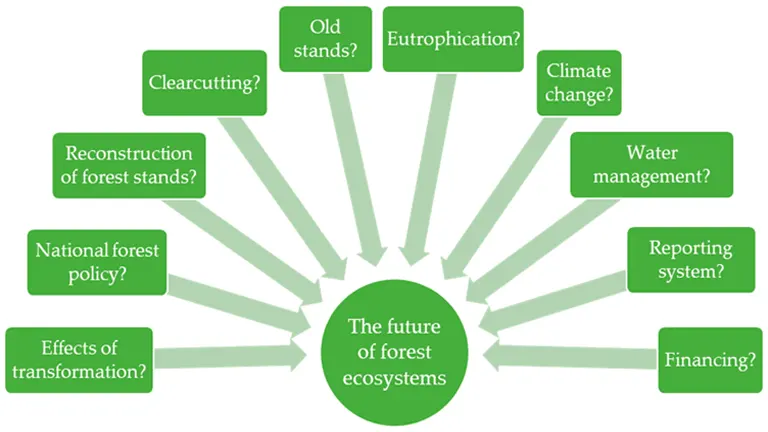Forest Policy and Economics Impact Factor: Best Guides for Solution
- September 19, 2024
- 0 comment
The journal Forest Policy and Economics plays an essential role in the fields of forestry and environmental economics by exploring the relationships between forest management, economics, and public policy. It is crucial in shaping sustainable forest practices globally, influencing academic research, policymaking, and industry standards.

A key indicator of the journal’s impact is its impact factor, which reflects its scholarly relevance and authority. This metric underscores the journal’s importance in fostering discussions on sustainable forest management, resource economics, and the complex interactions between ecological systems and economic policies.
Table of Contents:
- Impact Factor of Forest Policy and Economics
- Focus Areas in Forest Policy and Economics
- The Role of Impact Factor in Academic and Policy Influence
- Peer Review and Editorial Standards
- The Importance of Open Access and Accessibility
- Trends and Future Directions in Forest Policy and Economics
What is the Impact Factor?
The impact factor is a bibliometric measure used to evaluate the relative importance of a journal within its field. It is calculated by averaging the number of citations received by articles published in a journal over a specific period, usually two years. Journals with high impact factors are typically considered more influential, as their articles tend to be referenced more frequently by other researchers.
- Definition: A metric indicating the average number of citations per article published in a journal.
- Purpose: Measures a journal’s influence in its field.
- Calculation: Citations received in the last two years divided by the number of articles published.
- Frequency: Usually calculated annually.
- High Impact: Indicates significant academic influence.
- Journal Prestige: Higher impact factor equals higher reputation.
- Field Relevance: Varies across disciplines.
- Influence on Publishing: Authors often prefer journals with higher impact factors for greater visibility.
Impact Factor of Forest Policy and Economics
As of 2023, the impact factor of Forest Policy and Economics is one of the critical indicators of its growing significance. It consistently ranks among the top journals in environmental science, forestry, and resource economics. This high impact factor demonstrates its importance in advancing forest policy discussions, addressing the economic dimensions of forest resources, and informing decision-makers at both national and international levels.

| Factor | Value Without Impact Factor | Value With High Impact Factor |
|---|---|---|
| Citations per Article | Low | High |
| Journal Influence | Limited | Significant |
| Author Preference | Moderate | High (preferred by top researchers) |
| Research Visibility | Restricted | Broad (global recognition) |
| Policy Impact | Minimal | High (informs policy decisions) |
The journal’s consistently strong performance is a reflection of its rigorous peer-review process and the relevance of the topics it publishes. Articles cover a wide array of issues, from forest governance and biodiversity conservation to economic policies shaping timber markets and climate change adaptation strategies.
Focus Areas in Forest Policy and Economics
- Forest Governance and Management: One of the journal’s primary areas of focus is the governance and management of forest ecosystems. Research published here often delves into how policies shape forest governance structures, stakeholder involvement, and the balance between conservation and utilization. Articles exploring issues such as decentralized governance, community-based forest management, and regulatory frameworks are highly influential in driving both academic and policy discourse.
- Forest Economics: The economics of forest management and policy is another cornerstone of the journal. Forest Policy and Economics publishes research that examines how economic incentives, pricing mechanisms, and market-based approaches can promote sustainable forest practices. Topics such as the valuation of ecosystem services, the economic impact of deforestation, and trade in forest products are common themes.
- Environmental Policy and Climate Change: With climate change being a central global challenge, the journal has increasingly published research that explores the role of forests in mitigating climate change. Articles that address the economic benefits of carbon sequestration, the impact of REDD+ (Reducing Emissions from Deforestation and Forest Degradation), and how international agreements like the Paris Agreement influence forest policy are particularly relevant in this context.
- Biodiversity and Conservation: Biodiversity conservation is a critical issue in forest policy, and the journal frequently publishes research that explores the complex relationship between forest ecosystems and biodiversity. Topics include the role of protected areas, the economic benefits of biodiversity conservation, and policy frameworks that balance conservation with sustainable use.
The Role of Impact Factor in Academic and Policy Influence

- Academic Influence: For researchers and academics, the impact factor of a journal is an important consideration when choosing where to publish. Journals with higher impact factors are more likely to reach a broader audience and influence subsequent research. The strong impact factor of Forest Policy and Economics ensures that it remains a preferred venue for scholars who are advancing the frontiers of forest policy and economics research.
- Policy Influence: In addition to its academic importance, the high impact factor also reflects the journal’s policy relevance. Research published in Forest Policy and Economics is often used by policymakers to design and implement effective forest management strategies. Whether it is informing national forest policies or contributing to global discussions on climate change, the research published in this journal has real-world implications that extend beyond academia.
Peer Review and Editorial Standards
The high impact factor of Forest Policy and Economics can be attributed to its stringent editorial standards and rigorous peer review process.
| Factor | Low Standards | High Standards (Forest Policy and Economics) |
|---|---|---|
| Manuscript Rejection Rate | Low (accepts most papers) | High (selective acceptance) |
| Review Process Time | Short (fewer reviews) | Longer (rigorous multiple reviews) |
| Research Quality | Variable | High (strict quality checks) |
| Impact on Journal Reputation | Limited | Significant (enhances credibility) |
| Author Satisfaction | Moderate | High (clear feedback, improvements) |
Submissions undergo multiple rounds of evaluation to ensure that only high-quality, original research is published. This ensures that the articles contribute significantly to the field and are of interest to both academic researchers and policy practitioners.
The Importance of Open Access and Accessibility
With the growing demand for accessible academic research, Forest Policy and Economics offers several open access options for authors.
| Factor | Without Open Access | With Open Access |
|---|---|---|
| Research Visibility | Limited to subscribers | Broad global reach |
| Citation Rate | Lower (restricted access) | Higher (more accessible) |
| Impact on Policy | Lower | Significant (wider use) |
| Reader Demographics | Academics, institutions | Academics, policymakers, public |
| Cost for Readers | Subscription/Paywalls | Free (Open Access fees covered by authors) |
This ensures that research published in the journal is available to a wider audience, including policymakers, practitioners, and researchers in developing countries. Increased accessibility can lead to more citations, further enhancing the journal’s impact factor.
Trends and Future Directions in Forest Policy and Economics

- Integration of Technology: One emerging trend in the field of forest policy and economics is the integration of new technologies, such as remote sensing, geographic information systems (GIS), and artificial intelligence (AI). These technologies offer new ways to monitor forests, assess the economic impacts of policy changes, and predict future trends in forest ecosystems.
- Sustainable Development Goals (SDGs): The journal is also contributing to discussions around the United Nations Sustainable Development Goals (SDGs), particularly those related to life on land (SDG 15) and climate action (SDG 13). Research in these areas explores how forest policy can align with broader global sustainability objectives, emphasizing the need for integrated approaches to forest management that consider both economic and environmental factors.
- Climate Change Adaptation and Mitigation: As climate change continues to impact forest ecosystems, future research in Forest Policy and Economics is expected to focus increasingly on adaptation and mitigation strategies. Topics such as forest carbon credits, reforestation projects, and the role of forests in climate resilience will likely gain prominence in the journal’s publications.
Final Conclusion
The impact factor of Forest Policy and Economics underscores the journal’s importance in shaping both academic research and practical policy in the fields of forestry and environmental economics. By publishing cutting-edge research on forest management, economics, and sustainability, the journal contributes to a more informed and effective global approach to forest conservation and resource use. As the world continues to grapple with the dual challenges of climate change and biodiversity loss, the role of Forest Policy and Economics will only become more critical in guiding both policy and academic discourse.
Frequently Asked Questions (FAQs)
- What is the current impact factor of Forest Policy and Economics?
As of 2023, the journal’s impact factor is a critical metric reflecting its prominence in forest economics and policy. It showcases the frequency with which its articles are cited in scholarly work, indicating the journal’s relevance in both academic and policy circles. - How is the impact factor of a journal like Forest Policy and Economics calculated?
The impact factor is calculated by dividing the number of citations to the journal’s articles from the previous two years by the total number of articles published during that same period. This calculation provides an average citation rate per article. - Why is the impact factor considered important in academic publishing?
The impact factor serves as a measure of a journal’s influence within its field. A high impact factor indicates that research from the journal is widely cited, demonstrating its importance to ongoing academic discourse. It also helps researchers choose impactful journals for publication. - What are the primary research topics covered by Forest Policy and Economics?
The journal explores diverse topics such as forest governance, economic valuation of ecosystem services, biodiversity conservation, forest resource management, the economic impacts of deforestation, timber market dynamics, and climate change adaptation policies. - How does the research published in Forest Policy and Economics influence policy-making?
Studies in the journal often shape national and international forest policies. Policymakers use the research to create sustainable forest management frameworks, address deforestation challenges, design carbon credit markets, and meet climate change goals. - How does open access affect the journal’s impact factor?
Open access significantly enhances the visibility of articles by making them available to a broader audience. This increased accessibility can lead to higher citation rates, directly influencing and boosting the journal’s impact factor. - How does Forest Policy and Economics contribute to global environmental sustainability goals?
By publishing research on sustainable forest management, the journal aligns with global sustainability initiatives like the United Nations Sustainable Development Goals (SDGs), particularly focusing on life on land (SDG 15) and climate action (SDG 13). - What is the peer review process like in Forest Policy and Economics?
The journal employs a rigorous peer review process. Manuscripts are evaluated by experts in forestry and economics, ensuring that published research meets high academic standards. This helps maintain the journal’s credibility and contributes to its high impact factor. - Who typically reads and contributes to Forest Policy and Economics?
The journal is read by academics, researchers, policymakers, environmental economists, and industry professionals involved in forest management. Contributions typically come from experts in forestry, economics, environmental science, and related fields. - What role does technology play in the research published by Forest Policy and Economics?
The journal increasingly publishes research integrating technology like remote sensing, geographic information systems (GIS), and artificial intelligence (AI) to monitor forests, assess policy impacts, and improve forest management strategies. This technological integration enhances the precision of policy recommendations.
We hope this has enhanced your understanding of the Forest Policy and Economics impact factor and its role in shaping forest management and environmental policy. Have thoughts or experiences to share? Join the discussion and inspire others to support sustainable forestry. Don’t forget to share this with those passionate about forest conservation and the importance of academic research in guiding future strategies for natural resource management.

Edward Smith
Forestry AuthorWoodworking is about more than crafting; it's a harmonious connection with nature, mastering tools, and preserving our environment. I'm here to share my knowledge and experiences with you, forging a future where we can embrace wood's beauty and utility while safeguarding our forests' health and diversity.



Leave your comment